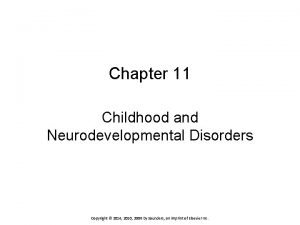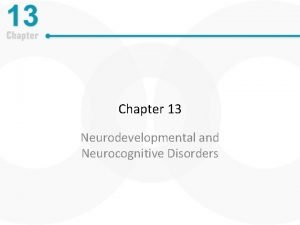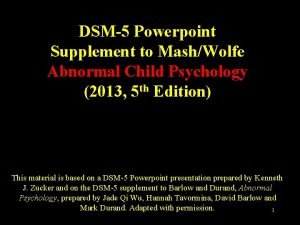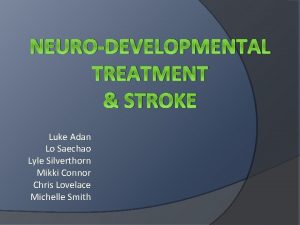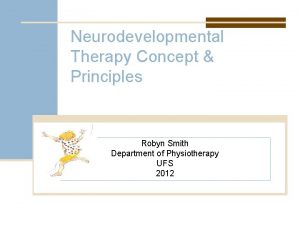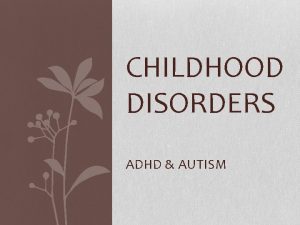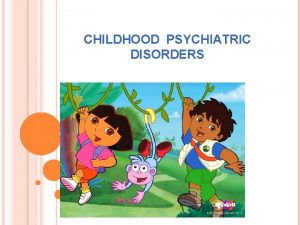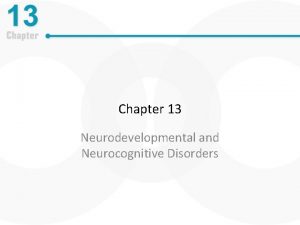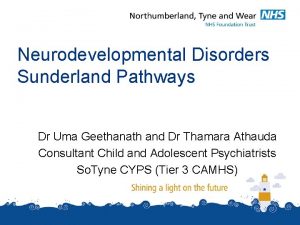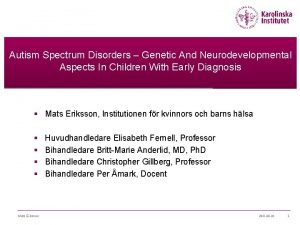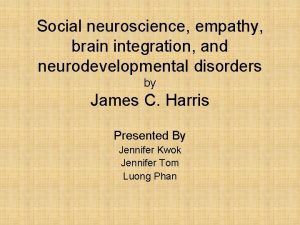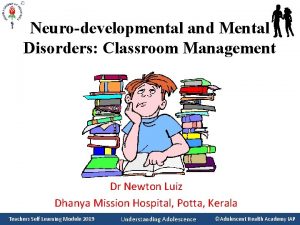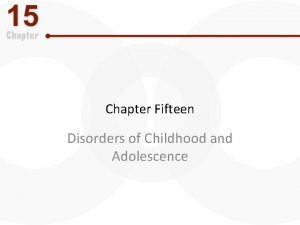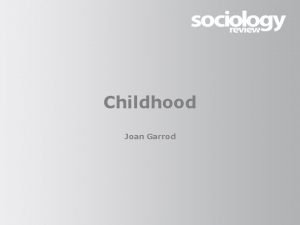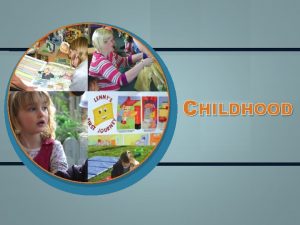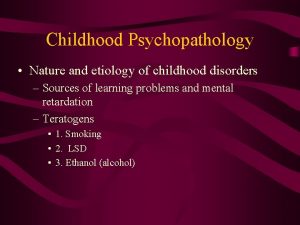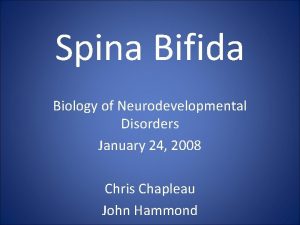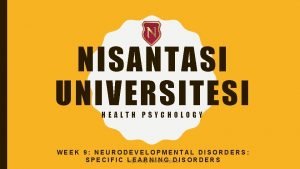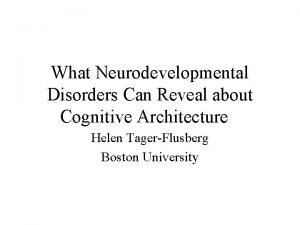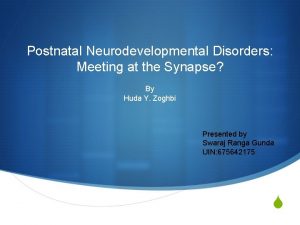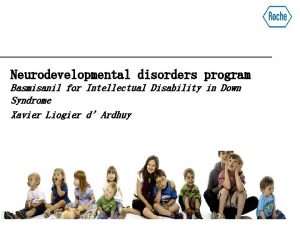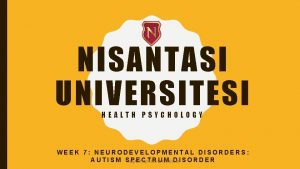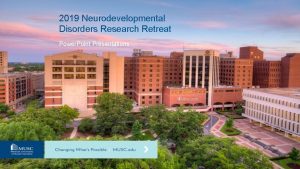Chapter 11 Childhood and Neurodevelopmental Disorders Copyright 2014






















- Slides: 22

Chapter 11 Childhood and Neurodevelopmental Disorders Copyright © 2014, 2010, 2006 by Saunders, an imprint of Elsevier Inc.

Introduction 75% of adults diagnosed with psychiatric disorders first diagnosed between ages 11 and 18 years Disruption to normal pattern of childhood development Difficulty diagnosing younger people Lack of services and premature termination of treatment Copyright © 2014, 2010, 2006 by Saunders, an imprint of Elsevier Inc. 2

Etiology Biological factors Genetic Ø Neurobiological Ø Psychological factors Temperament Ø Resilience Ø Environmental factors Cultural Copyright © 2014, 2010, 2006 by Saunders, an imprint of Elsevier Inc. 3

Case Study A child with many “risk factors” for the development of mental illness develops normally. You hear the term resilience used. What are some characteristics this child has? Copyright © 2014, 2010, 2006 by Saunders, an imprint of Elsevier Inc. 4

Case Study (Cont. ) What are some familial risk factors that appear to be related to a child’s experiencing a psychiatric disorder? Copyright © 2014, 2010, 2006 by Saunders, an imprint of Elsevier Inc. 5

Assessing Development and Functioning Assessment data Data collection Mental status examination Developmental assessment Copyright © 2014, 2010, 2006 by Saunders, an imprint of Elsevier Inc. 6

General Interventions for Children and Adolescents Family therapy Group therapy Behavioral therapy Cognitive behavioral therapy Disruptive behavior management Time-out Quiet room Copyright © 2014, 2010, 2006 by Saunders, an imprint of Elsevier Inc. 7

General Interventions (Cont. ) Play therapy Bibliotherapy Therapeutic drawing Music therapy Psychopharmacology Team work and safety Copyright © 2014, 2010, 2006 by Saunders, an imprint of Elsevier Inc. 8

Communication Disorders Speech disorders Language disorders Copyright © 2014, 2010, 2006 by Saunders, an imprint of Elsevier Inc. 9

Learning Disorders Dyslexia (reading) Dyscalculia (math) Dysgraphia (written expression) Copyright © 2014, 2010, 2006 by Saunders, an imprint of Elsevier Inc. 10

Motor Disorders Stereotypic movement disorder Tourette’s disorder Copyright © 2014, 2010, 2006 by Saunders, an imprint of Elsevier Inc. 11

Intellectual Development Disorder Deficits in Intellectual functioning Ø Social functioning Ø Managing age-appropriate activities of daily living, functioning at school or work, and performing selfcare Ø Copyright © 2014, 2010, 2006 by Saunders, an imprint of Elsevier Inc. 12

Autism Spectrum Disorder Neurobiological disability Developmental disability Appears during first 3 years of life Copyright © 2014, 2010, 2006 by Saunders, an imprint of Elsevier Inc. 13

Autism Spectrum Disorder: Application of the Nursing Process Assessment Diagnosis Outcomes Identification Implementation Psychosocial interventions Ø Psychobiological interventions Ø Evaluation Copyright © 2014, 2010, 2006 by Saunders, an imprint of Elsevier Inc. 14

Case Study (Cont. ) If a child is diagnosed with autism, what type of treatment will be recommended? Copyright © 2014, 2010, 2006 by Saunders, an imprint of Elsevier Inc. 15

Attention Deficit Hyperactivity Disorder Inappropriate degree of Inattention Ø Impulsiveness Ø Hyperactivity Ø Copyright © 2014, 2010, 2006 by Saunders, an imprint of Elsevier Inc. 16

Attention Deficit Hyperactivity Disorder (Cont. ) Assessment Level of physical activity, attention span, talkativeness Ø Social skills Ø Comorbidity Ø Diagnosis Outcomes Identification Copyright © 2014, 2010, 2006 by Saunders, an imprint of Elsevier Inc. 17

Attention Deficit Hyperactivity Disorder (Cont. ) Implementation Psychosocial interventions Ø Psychobiological interventions Ø • Psychopharmacology Evaluation Copyright © 2014, 2010, 2006 by Saunders, an imprint of Elsevier Inc. 18

Question 1 Which statement demonstrates that a parent understands the diagnosis of attention deficit hyperactivity disorder? A. “My child will never be able to graduate or go to college but may be able to learn a vocational skill. ” B. “My child’s performance will improve in a structured setting that provides rewards for appropriate behavior. ” Copyright © 2014, 2010, 2006 by Saunders, an imprint of Elsevier Inc. 19

Question 1 (Cont. ) A. “Nothing is wrong with my child. The school hasn’t provided qualified teachers and classroom settings. ” B. “My child is just going through a stage. This problem will go away with time. ” Copyright © 2014, 2010, 2006 by Saunders, an imprint of Elsevier Inc. 20

Audience Response Questions 1. Which child would be most difficult to diagnose for a neurodevelopmental disorder? A. 3 year old B. 5 year old C. 8 year old D. 12 year old Copyright © 2014, 2010, 2006 by Saunders, an imprint of Elsevier Inc. 21

Audience Response Questions 2. A 4 -year-old frequently lashes out in anger at adults and other children. This child’s style of behavior is an aspect of A. neurobiology. B. temperament. C. resilience. D. culture. Copyright © 2014, 2010, 2006 by Saunders, an imprint of Elsevier Inc. 22
 Chapter 11 childhood and neurodevelopmental disorders
Chapter 11 childhood and neurodevelopmental disorders Neurocognitive disorders
Neurocognitive disorders Childhood disorders dsm-5 ppt
Childhood disorders dsm-5 ppt Neurodevelopmental disorders
Neurodevelopmental disorders Early childhood
Early childhood Neurodevelopmental treatment for stroke
Neurodevelopmental treatment for stroke Robyn smith therapist
Robyn smith therapist 2014 pearson education inc
2014 pearson education inc Chapter 8 skin disorders and diseases review questions
Chapter 8 skin disorders and diseases review questions Chapter 6 musculoskeletal system diseases and disorders
Chapter 6 musculoskeletal system diseases and disorders Chapter 46 digestive and endocrine disorders
Chapter 46 digestive and endocrine disorders Chapter 29 somatic symptom and dissociative disorders
Chapter 29 somatic symptom and dissociative disorders Chapter 29 endocrine and metabolic disorders
Chapter 29 endocrine and metabolic disorders Chapter 21 mental health diseases and disorders
Chapter 21 mental health diseases and disorders Chapter 18 eating and feeding disorders
Chapter 18 eating and feeding disorders Chapter 17 reproductive system diseases and disorders
Chapter 17 reproductive system diseases and disorders Chapter 15 nervous system diseases and disorders
Chapter 15 nervous system diseases and disorders Chapter 15 anxiety and obsessive-compulsive disorders
Chapter 15 anxiety and obsessive-compulsive disorders Elsevier
Elsevier What condition do fungal organisms favor for growth
What condition do fungal organisms favor for growth Milady chapter 10
Milady chapter 10 Cardiovascular system diseases and disorders chapter 8
Cardiovascular system diseases and disorders chapter 8 Milady chapter 8 skin disorders and diseases
Milady chapter 8 skin disorders and diseases
